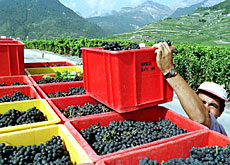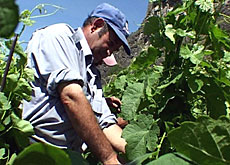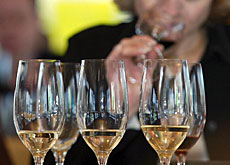Swiss wine of 2004 will be a corker

This year's Swiss wine harvest is likely to be an exceptional vintage, with fine weather in the autumn making up for a poor summer.
The harvest will also be bigger than in 2003.
“The 2004 vintage was one accompanied by many fears,” commented Philippe Herminjard at the Federal Office for Agriculture.
He said that until the end of August, bad weather conditions were pointing to a poor year compared with the excellent 2003 vintage.
“Thankfully, the month of September was exceptional and encouraged the ripening of the grapes,” he added.
Herminjard said that the wine would be particularly good in the Valais, Chablais and Lavaux regions, as well as in parts of the southern canton of Ticino.
A representative of the wine industry in Valais, Switzerland largest wine-producing canton, told swissinfo that the harvest was about average in terms of quantity.
“Excellent”
“But the quality is excellent, in line with that of the vintage of 2000, which was exceptional,” commented Pierre Devanthéry who is head of the canton’s umbrella organisation of wine growers and producers.
He said Valais had benefited from 1,546 hours of sunshine between April and October.
“The exceptional climate of Valais is good for the speciality grapes that are grown, which now represent a fifth of the canton’s production.
“And we have seen a good progression of the two star grapes – the Petite Arvine and the Cornalin,” he added.
The Swiss wine harvest this year produced 116 million litres of must, 18.9 million litres more than in 2003. But this is slightly less than in previous years, the Office said in a communiqué on Thursday.
More red
In 2002, Swiss vintners for the first time produced slightly more red wine than white. The difference was more marked this year, with 60.5 million litres of red compared with 55.4 million litres of white.
The Office noted that this development was the result of opening the market to foreign competition and the growing of different grape varieties.
Vintners have been replacing their Chasselas and Müller-Thurgau grapes with other white grapes and with red grapes that are better adapted to current consumer tastes and trends.
The Office added that Swiss wines were increasingly been seen as an accompaniment to a good meal.
The Swiss government and some cantons have been using financial incentives to encouraging the changes in the Swiss wine landscape.
Since 2002, the surface of vineyards with white grapes has gone down by 325 hectares (-77 hectares in 2004), while that with red grapes has risen by 247 hectares (+84 hectares in 2004).
swissinfo with agencies
Valais is Switzerland’s leading wine canton, followed by Vaud and Ticino.
In Western Switzerland, more than half of the grapes grown are white varieties (52 per cent).
93 per cent of Ticino’s grapes are red varieties.
In the German-language part of Switzerland, 72 per cent of grape varieties grown are red.
The 2004 vintage produced 116 million litres of must – 18.9 million litres more than in 2003.
This year’s harvest produced 60.5 million litres of red wine and 55.4 million litres of wine.
Vintners have been growing different grapes to take into account current consumer tastes and trends.
Annual production regularly hits 200 million bottles, but many wines don’t get beyond the borders of their canton (just one percent goes for export).

In compliance with the JTI standards
More: SWI swissinfo.ch certified by the Journalism Trust Initiative



You can find an overview of ongoing debates with our journalists here . Please join us!
If you want to start a conversation about a topic raised in this article or want to report factual errors, email us at english@swissinfo.ch.